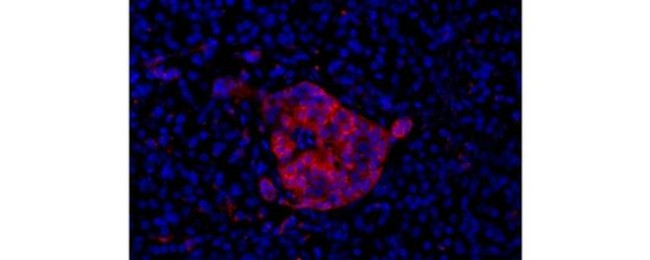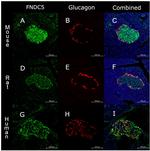Search
Invitrogen
Glucagon Monoclonal Antibody (ICACLS), eFluor™ 570, eBioscience™
{{$productOrderCtrl.translations['antibody.pdp.commerceCard.promotion.promotions']}}
{{$productOrderCtrl.translations['antibody.pdp.commerceCard.promotion.viewpromo']}}
{{$productOrderCtrl.translations['antibody.pdp.commerceCard.promotion.promocode']}}: {{promo.promoCode}} {{promo.promoTitle}} {{promo.promoDescription}}. {{$productOrderCtrl.translations['antibody.pdp.commerceCard.promotion.learnmore']}}
产品信息
41-9743-82
种属反应
宿主/亚型
分类
类型
克隆号
偶联物
激发/发射光谱
形式
浓度
纯化类型
保存液
内含物
保存条件
运输条件
RRID
产品详细信息
Description: This ICACLS monoclonal antibody reacts with human, mouse, and rat glucagon. Glucagon is a peptide hormone secreted by the pancreatic alpha cells found within the islets of Langerhans. Glucagon functions as an antagonist to insulin and homeostatic regulation of blood glucose levels are maintained by the critical balance between these two hormones. Glucagon acts in the liver to convert glycogen to glucose by promoting gluconeogenesis and glycogenolysis. Secretion of glucagon is stimulated by hypoglycemia, epinephrine, acetylcholine, and cholecystokinin, while secretion is inhibited by insulin and somatostatin. Abnormally high levels of glucagon are found in pancreatic tumors.
Applications Reported: This ICACLS antibody has been reported for use in immunohistochemical staining, and immunohistochemical staining of formalin-fixed paraffin embedded tissue sections.
Applications Tested: This ICACLS antibody has been tested by immunohistochemistry of formalin-fixed paraffin embedded human tissue using low pH antigen retrieval at less than or equal to 20 µg/mL. It is recommended that the antibody be carefully titrated for optimal performance in the assay of interest.
Filter Recommendation: When using this eFluor® 570 antibody conjugate, we recommend a filter that will capture the 570 emission wavelength (for example, Excitation 545/25, 565LP, Emission 605/70). A standard Alexa Fluor® 555 or TRITC filter is acceptable.
Excitation: 555 nm; Emission: 570 nm
靶标信息
Glucagon is a 29-residue polypeptide hormone (MW 3482), produced in the pancreas. A related hormone, enteroglucagon (or oxyntomodulin), which is produced in the mucosa of the small and large intestine, consists of the 29 amino acid sequence of pancreatic glucagon extended by 8 additional residues at the C-terminus. The biological activities of pancreatic glucagon include glycogenolysis, lipolysis, gluconeogenesis, and ketogensis, which are antagonistic effects to those of insulin action, thus leading to increased blood glucose levels. Immunocytochemical studies have revealed the presence of pancreatic glucagon inside the A or alpha cells, which constitute 15-20% of the islet cell population. These cells are located preferentially at the periphery of the human pancreatic islets. Pathological manifestations of the glucagon-type peptide residue almost exclusively with the exsistence of tumors or glucagonomas, as no states of glucagon-cell deficiency or hyperplasia have been identified. Glucagon-specific antibodies would prove useful as a cell and tumor markers applying immunohistochemical techniques, and as an analytical tool in qualification of the hormone.
仅用于科研。不用于诊断过程。未经明确授权不得转售。
生物信息学
蛋白别名: glicentin-related polypeptide; GLP1/2; glucagon; glucagon-like peptide 1; glucagon-like peptide 2; glucagon-like peptide-1; IL12p35; IL12P40; OXY; preproglucagon; Pro-glucagon
基因别名: GCG; GLP-1; GLP1; GLP2; Glu; GRPP; PPG
UniProt ID: (Human) P01275, (Mouse) P55095
Entrez Gene ID: (Human) 2641, (Mouse) 14526, (Rat) 24952






